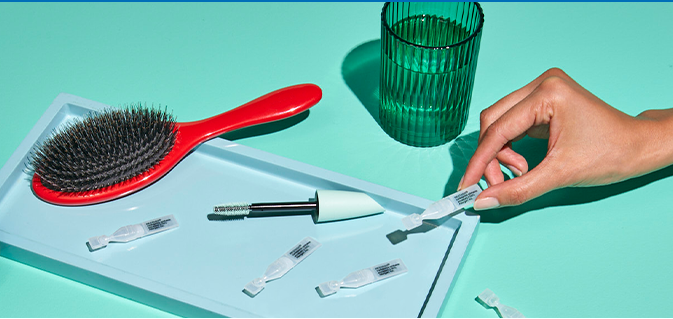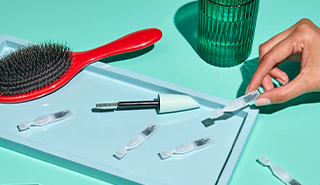FREQUENTLY
ASKED QUESTIONS


ABOUT CHRONIC DRY EYE
PRODUCT INFORMATION
*RESTASIS® (single-use vials) Projected Patient Counts, SOW 2016-04
- Pull off the clear shipping cover by pulling straight up, and then throwing it away.
- Next remove the pull tab on the green-colored protective cap by pulling the end of the pull tab away from the bottle, then winding it counterclockwise. Throw the pull tab away. Don't use RESTASIS MultiDose® if either the shipping cover or the pull tab are damaged or missing.
- Then remove the green-colored protective cap by pulling it straight up. Be sure to keep this protective cap.
- Prime the bottle for the first time by squeezing 2 drops onto a tissue. Don't let the bottle tip touch the tissue.
- Then place the green-colored protective cap back by pushing it straight down onto the bottle. Now RESTASIS MultiDose® is ready to use.
- Turn the bottle upside down a few times to make sure the medicine is mixed well.
- Instill one drop in each eye.
- Then replace the green-colored protective cap by pushing it straight down onto the bottle until you're ready to use RESTASIS MultiDose® again.
- Do not touch the bottle tip to your eye or other surfaces.
- Before using RESTASIS®, turn the single-dose vial upside down a few times to shake it up and make sure you get a uniform, white, opaque emulsion.
- Do not touch the vial tip to your eye or other surfaces.
- Discard each single-dose vial after use.
INSURANCE AND COST
Check with your insurance plan. You may have both vision insurance and medical insurance. Vision insurance may pay only for routine visual exams. Medical insurance may pay for exams that check for eye diseases including Chronic Dry Eye disease. Insurance plan coverage and out-of-pocket cost will vary depending on your individual plan.
Some eye doctors accept both vision insurance and medical insurance, depending on the reason for your visit. To get screened for a type of Chronic Dry Eye disease, don’t wait for your annual vision exam because screening for a disease is more likely to be covered by your medical insurance.
When you schedule your Chronic Dry Eye disease screening, make sure the office staff schedules you for a medical appointment and not your annual vision exam.
SAVINGS AND SUPPORT
RESTASIS® and RESTASIS MultiDose® Ophthalmic Emulsion help increase your eyes’ natural ability to produce tears, which may be reduced by inflammation due to Chronic Dry Eye. RESTASIS® and RESTASIS MultiDose® did not increase tear production in patients using anti-inflammatory eye drops or tear duct plugs.
Do not use RESTASIS® and RESTASIS MultiDose® Ophthalmic Emulsion if you are allergic to any of the ingredients. Be careful not to touch the container tip to your eye or other surfaces, to help avoid eye injury and contamination. RESTASIS® and RESTASIS MultiDose® should not be used while wearing contact lenses. If contact lenses are worn, they should be removed prior to use of RESTASIS® and RESTASIS MultiDose® and may be reinserted after 15 minutes.
The most common side effect is a temporary burning sensation. Other side effects include eye redness, discharge, watery eyes, eye pain, foreign body sensation, itching, stinging, and blurred vision.
You are encouraged to report negative side effects of prescription drugs to the FDA. Visit
www.fda.gov/medwatch FDA Goverment Website
Click here for full Product Information for
RESTASIS® 

APPROVED USE
RESTASIS® and RESTASIS MultiDose® Ophthalmic Emulsion help increase your eyes’ natural ability to produce tears, which may be reduced by inflammation due to Chronic Dry Eye. RESTASIS® and RESTASIS MultiDose® did not increase tear production in patients using anti-inflammatory eye drops or tear duct plugs.
IMPORTANT SAFETY INFORMATION
Do not use RESTASIS® and RESTASIS MultiDose® Ophthalmic Emulsion if you are allergic to any of the ingredients. Be careful not to touch the container tip to your eye or other surfaces, to help avoid eye injury and contamination. RESTASIS® and RESTASIS MultiDose® should not be used while wearing contact lenses. If contact lenses are worn, they should be removed prior to use of RESTASIS® and RESTASIS MultiDose® and may be reinserted after 15 minutes.
The most common side effect is a temporary burning sensation. Other side effects include eye redness, discharge, watery eyes, eye pain, foreign body sensation, itching, stinging, and blurred vision.
You are encouraged to report negative side effects of prescription drugs to the FDA. Visit
www.fda.gov/medwatch FDA Goverment Website
Click here for full Product Information for
RESTASIS® 

